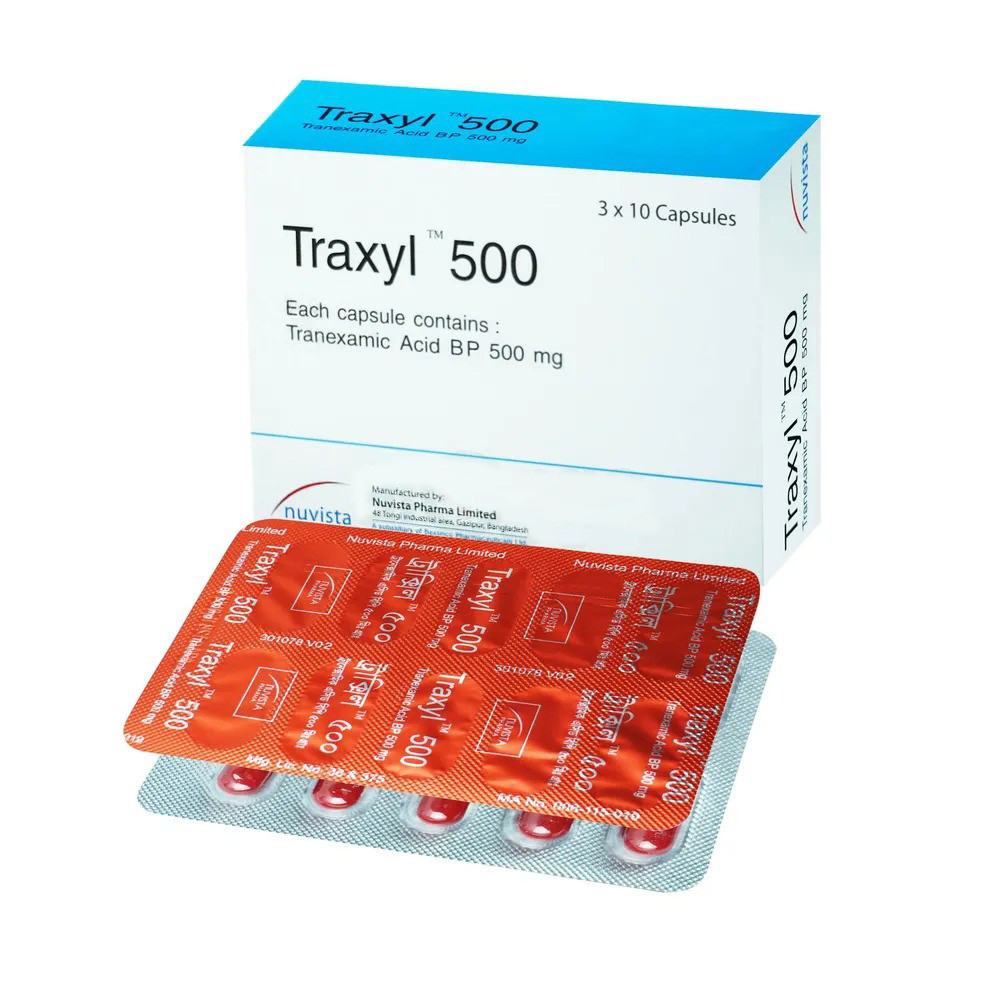
✔ 100% Authentic Product
👁️ Currently Viewing 7545
Tranexamic Acid (trans-4 aminomethyl-cyclohexanecarboxylic acid) is a potent antifibrinolytic agent, approximately ten times more effective than traditional hemostatic agents. It works by inhibiting the activation of plasminogen by both endogenous (e.g., urokinase) and exogenous (e.g., streptokinase) activators. This mechanism ensures effective bleeding control across various conditions.
Tranexamic Acid has a low acute toxicity profile and minimal chronic toxicity. It is well-absorbed orally, with effects seen within 15-30 minutes, and is primarily excreted through the kidneys at a slower rate than conventional hemostatics, providing a longer-lasting effect. Therapeutic doses do not interfere with normal clotting processes or promote thrombophilia, even with prolonged use.
Discount
Price: ৳ 235
MRP:
৳
250
6%
Off

100% Genuine Products, Guaranteed

Safe & Secure Payments, Always

Fast, Secure & Efficient Delivery

Proper Packaging
 Cash on Delivery - All over Bangladesh
Cash on Delivery - All over Bangladesh Regular Delivery - 12-24 Hours, Dhaka City* Charge Tk.39-59
Regular Delivery - 12-24 Hours, Dhaka City* Charge Tk.39-59 Regular Delivery - 24-48 Hours, Other Cities* Charge Tk.99-110
Regular Delivery - 24-48 Hours, Other Cities* Charge Tk.99-110
 ফ্রি ডেলিভারিঃ - ৯৯৯ টাকা+ অর্ডারে, ঢাকা
শহরে
ফ্রি ডেলিভারিঃ - ৯৯৯ টাকা+ অর্ডারে, ঢাকা
শহরে ফ্রি ডেলিভারিঃ - ২৯৯৯ টাকা+ অর্ডারে, ঢাকার
বাহিরে
ফ্রি ডেলিভারিঃ - ২৯৯৯ টাকা+ অর্ডারে, ঢাকার
বাহিরে
100% Genuine Products, Guaranteed
Safe & Secure Payments, Always
Fast, Secure & Efficient Delivery
Proper Packaging
 Cash on Delivery - All over Bangladesh
Cash on Delivery - All over Bangladesh Regular Delivery - 12-24 Hours, Dhaka City* Charge Tk.39-59
Regular Delivery - 12-24 Hours, Dhaka City* Charge Tk.39-59 Regular Delivery - 24-48 Hours, Other Cities* Charge Tk.99-110
Regular Delivery - 24-48 Hours, Other Cities* Charge Tk.99-110 ফ্রি ডেলিভারিঃ - ৯৯৯ টাকা+ অর্ডারে, ঢাকা
শহরে
ফ্রি ডেলিভারিঃ - ৯৯৯ টাকা+ অর্ডারে, ঢাকা
শহরে ফ্রি ডেলিভারিঃ - ২৯৯৯ টাকা+ অর্ডারে, ঢাকার
বাহিরে
ফ্রি ডেলিভারিঃ - ২৯৯৯ টাকা+ অর্ডারে, ঢাকার
বাহিরে
✅ Description:

✔️ Tranexamic Acid 500mg Capsule
In Medicine:
- Prophylaxis and treatment of hemoptysis, gastrointestinal bleeding, hemorrhagic conditions in leukemia, cirrhosis, hemophilia, thrombocytopenic purpura, thrombolytic therapy complications, and transfusion-related accidents.
In Surgery:
- Prevention and control of bleeding during surgeries, especially in pulmonary, cardiovascular, abdominal, and urological procedures. Useful in post-operative bleeding and traumatic shock.
In Urology:
- Prophylaxis and treatment of bleeding during surgeries of the prostate, bladder, and kidneys. Effective for hematuria.
In Obstetrics:
- Prevention and treatment of post-partum and puerperium hemorrhages, abnormal uterine bleeding (idiopathic or IUD-induced), and hemorrhages due to abruptio placentae or premature placental detachment. Used during cervical conization.
In Otorhinolaryngology:
- Prophylaxis and treatment of bleeding during tonsillectomies, specialized surgeries, and epistaxis.
In Stomatology:
- Prevention and treatment of bleeding during maxillofacial surgeries and tooth extractions.
In Oncology (supportive therapy):
- Helps form a fibrin capsule around ovarian tumors to limit their growth. Reduces ascites caused by carcinoma and minimizes bleeding during cancer surgeries.
✔️ Dosage & Administration of Traxyl 500
Adults:
- General dose: 500-1000 mg taken three times daily.
- For prophylaxis: 0.5-1 g orally or 500 mg via intravenous or intramuscular routes daily.
- For bleeding management: 1-3 g orally in divided doses. For urgent cases, start with a 500 mg intravenous injection, followed by oral doses as needed.
Children:
- Prophylaxis: 5-10 mg/kg daily, divided into multiple doses.
- Treatment: Oral doses are increased to 10-20 mg/kg. For intravenous or intramuscular use, begin with 10 mg/kg (0.5 mL per 5 kg) administered slowly. Diluted ampoules may also be given orally for convenience.
Elderly:
- No dosage adjustments are required unless renal function is impaired.
✔️ Side Effects
- Common: Fatigue, nasal congestion, skin redness, itching, and conjunctival irritation.
- Gastrointestinal: Nausea, diarrhea, and heartburn.
- Rare: Postural hypotension and hypersensitivity reactions requiring discontinuation.
✔️ Interaction
- Antibiotics: Incompatible with solutions containing penicillins (e.g., benzylpenicillin).
- Thrombolytics: Streptokinase and urokinase antagonize Tranexamic Acid’s effects.
- Oral Contraceptives: Concurrent use may increase the risk of thrombosis.
- Blood Transfusions: Avoid mixing Tranexamic Acid directly with whole blood.
✔️ Contraindications
- Hypersensitivity to Tranexamic Acid.
- Thromboembolic disorders, arterial and venous thrombosis, endocavitary bleeding, or severe renal failure.
✔️ Pregnancy & Lactation
- Tranexamic Acid should be avoided during pregnancy due to unknown transplacental effects.
- A minimal amount of the drug is excreted into breast milk, making an antifibrinolytic effect on the infant unlikely.
✔️ Precautions & Warnings
- Use only in cases of hyperfibrinolysis. Begin prophylactic treatment 24 hours before surgery and continue for 3-4 days post-surgery.
- Continue therapy for 24 hours after hemorrhagic symptoms resolve.
- Reduce doses in hematuria to prevent clot formation in the urinary tract.
- Avoid use in severe renal failure or anuric syndromes; use cautiously in patients with moderate renal dysfunction, heart disease, or liver disorders.
✔️ Storage Conditions
Store in a dry place at 15-30°C, away from light. Keep out of reach of children.
⚠️Disclaimer:
At ePharma, we’re committed to providing accurate and accessible health information. However, all content is intended for informational purposes only and should not replace medical advice from a qualified physician. Please consult your healthcare provider for personalized guidance. We aim to support, not substitute, the doctor-patient relationship.



















